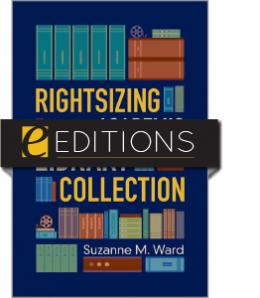
Rightsizing the Academic Library Collection—eEditions e-book
The download link for this product can be found on the final confirmation screen after you complete your purchase, and may also be accessed from your Account Profile. For more information about ALA eEditions file types and how to view them on eReaders, desktop computers, and other devices, see this page.
Primary tabs
You don't need to be an ALA Member to purchase from the ALA Store, but you'll be asked to create an online account/profile during checkout to proceed. This Web Account is for both Members and non-Members. Note that your ALA Member discount will be applied at the final step of the checkout process.
If you are Tax-Exempt, please verify that your account is currently set up as exempt before placing your order, as our new fulfillment center will need current documentation. Learn how to verify here.
- Description
- Table of Contents
- About the author
- Reviews
Is your institution's library bursting at the seams with books that have not been touched for decades, microfilm that nobody uses, and print journals that have been superseded by electronic access? Have you wondered how best to identify what physical material to retain and what to withdraw to maintain an inviting collection of relevant material for your users? Then it's time to rightsize! Ward identifies the challenges and proposes solutions to shaping physical collections for today's academic library. Filled with sage advice and ready-to-implement guidance, this book
- Introduces the concept of rightsizing, a strategic and largely automated approach that uses continuous assessment to identify the no- and low-use materials in the collection
- Walks you through crafting a rightsizing plan, from developing withdrawal criteria and creating discard lists to managing workflow and disposing of withdrawn materials
- Shows how to identify stakeholders, plus strategies for winning them over
- Offers tips for working with consortial partners on collaborative print retention projects
- Discusses how growing electronic collections can enhance legacy print collections
- Advises what to do with print journals after your library licenses perpetual access rights to the electronic equivalent
- Looks ahead to the future of physical collections in academic libraries
By learning how to rightsize, you will ensure that your institution's collection meets the needs of your library's users.
INTRODUCTION 1. BACKGROUNDChallenges facing colleges and universitiesAcademic libraries todayA rose by any other nameWhy rightsize?The digital revolutionProject genesisResistance to rightsizingStakeholdersUse studiesChanging environment 2. TRADITIONAL DESELECTION SOLUTIONSWithdrawals based on superseded volumesWithdrawals based on low circulation/low useWithdrawals based on electronic accessLocal storageRemote storageMoving beyond weeding and storage 3. RIGHTSIZING SOLUTIONSWithdrawal policyThe rightsizing planRules-based mass book withdrawalsMatching books against electronic collections Matching journals against electronic collectionsWithdrawals based on short or scattered holdingsDigitizationCollaborative storageCost 4. PROJECT MANAGEMENTStrategic rightsizing approachDisposal of withdrawn materialGetting started: a checklistManaging workflow: journalsManaging workflow: booksManaging workflow: microforms and audio visual materialRapid response scenarioProject conclusion Continuous assessment 5. THE FUTURE OF PHYSICAL COLLECTIONS IN ACADEMIC LIBRARIES Local collectionsRegional and research mega-collectionsFuture rightsizingConclusion
Suzanne M. Ward
Suzanne M. Ward retired in 2017 from the Purdue University Libraries in West Lafayette, Indiana. She published the first edition of Rightsizing the Academic Library Collection in 2015. She has also written extensively on patron-driven acquisitions, publishing A Guide to Implementing and Managing Patron-Driven Acquisitions in 2012 and making presentations on the topic both nationally and internationally. Her research interests included print retention issues and the use of e-books in academic libraries. Ward holds a BA from the University of California at Los Angeles, an AMLS from the University of Michigan, and an MA from the University of Memphis.
"As a recognized leader in the area of collection management, Ward provides both strategic and practical advice for developing and implementing data-driven, rules-based projects that include print and electronic formats. The final chapter on the future of physical collections in academic libraries is especially thought provoking … Recommended reading for all academic librarians and library managers."
— Library Journal (starred review)
"Critically important for professional librarians charged with maintaining the standards of an academic library, as well as an addition to university level Library Science curriculum supplemental reading lists."
— Library Bookwatch
"Along with outlining the necessary background, Ward identifies each potential stakeholder's reaction and highlights various pathways librarians must take in order to continue moving forward … Unlike other books of this kind that focus mostly on philosophy and theory, Rightsizing the Academic Library Collection provides a realistic blueprint to effectively start and finish this massive undertaking."
— VOYA
"Contains the practical elements of weeding both book and journal collections ... Recommended."
— CHOICE
"An excellent resource for any library considering a major weeding project in the near future. The figures and examples scattered throughout are perfect for libraries looking for ways to justify decisions, as well as offering firm rules that can be referred back to should others question the choices."
— Catholic Library World


